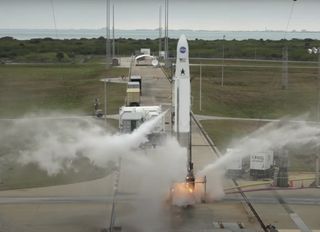Astra came tantalizingly close today (Feb. 7) to its first-ever launch of operational satellites.
The California company's Launch Vehicle 0008 (LV0008) was scheduled to launch the ELaNa 41 mission for NASA today from Cape Canaveral Space Force Station in Florida. And it nearly happened: LV0008's first-stage engines fired up at 1:50 p.m. EST (1850 GMT) as planned, but the rocket shut the liftoff attempt down almost immediately thereafter.
After analyzing the issue, Astra decided not to attempt another launch during today's window, which ran through 4 p.m. EST (2100 GMT).
Video: Watch Astra's Rocket 3.2 launch on its 1st successful flight

"Unfortunately, the abort that was around our T-0 time was a minor telemetry issue that the team needs to work to resolve," Carolina Grossman, Astra's director of product management, said during a webcast of today's try. "So unfortunately we need to stand down from today's launch attempt."
Astra will try again on Thursday (Feb. 10), during a launch window that opens at 3 p.m. EST (2000 GMT). You can watch that attempt live here at Space.com, courtesy of Astra and its livestream partner NASASpaceflight.com, or directly via the company.
Astra has conducted four orbital launches to date, all of them test missions from the Pacific Spaceport Complex in Alaska. The company reached space on two of those flights, and its LV0007 made it to orbit on the most recent mission, a trial for the U.S. military that launched in November.
Get the Space.com Newsletter
Breaking space news, the latest updates on rocket launches, skywatching events and more!
None of those test missions carried operational payloads. The 43-foot-tall (13 meters) LV0008, by contrast, will deliver four tiny cubesats to orbit on ELaNa 41, if all goes according to plan.
Those little satellites are flying via NASA's Educational Launch of Nanosatellites (ELaNa) initiative. They were built by teams at NASA's Johnson Space Center in Houston and three different universities (the University of Alabama, New Mexico State University and the University of California, Berkeley). You can read more about all four of them here.
Today's scrub was the second for the ELaNa 41 mission. It was originally supposed to launch on Saturday (Feb. 5), but that attempt was scuttled by an issue with the radar system at the launch range.
Editor's note: This story was updated at 8:30 p.m. EST on Feb. 8 with news of the Feb. 10 target date.
Mike Wall is the author of "Out There" (Grand Central Publishing, 2018; illustrated by Karl Tate), a book about the search for alien life. Follow him on Twitter @michaeldwall. Follow us on Twitter @Spacedotcom or on Facebook.
Join our Space Forums to keep talking space on the latest missions, night sky and more! And if you have a news tip, correction or comment, let us know at: community@space.com.

Michael Wall is a Senior Space Writer with Space.com and joined the team in 2010. He primarily covers exoplanets, spaceflight and military space, but has been known to dabble in the space art beat. His book about the search for alien life, "Out There," was published on Nov. 13, 2018. Before becoming a science writer, Michael worked as a herpetologist and wildlife biologist. He has a Ph.D. in evolutionary biology from the University of Sydney, Australia, a bachelor's degree from the University of Arizona, and a graduate certificate in science writing from the University of California, Santa Cruz. To find out what his latest project is, you can follow Michael on Twitter.
